When Sarah hosted her first holiday dinner, she discovered that a honey-glazed spiral ham with pineapple chutney transformed her gathering from ordinary to extraordinary. You'll find this classic dish strikes the perfect balance between sweet and savory, while its elegant presentation demands attention at any table. Whether you're planning a special occasion or seeking to master this timeless favorite, understanding the techniques behind this centerpiece dish will elevate your culinary expertise.
Key Takeaways
- The spiral-cut ham requires an internal temperature of 140°F (60°C) and should rest for 20 minutes before serving.
- Brush honey glaze over the ham's surface and between slices, applying in two stages during the baking process.
- Prepare pineapple chutney in advance to enhance flavor and provide a sweet-tangy contrast to the ham's saltiness.
- Caramelization occurs during the final 30 minutes of uncovered baking, creating a deliciously glazed exterior.
- Serve with traditional sides like mashed potatoes, and garnish with fresh pineapple slices for visual appeal.
History
While honey-glazed hams have graced American holiday tables since the mid-20th century, their origins can be traced back to ancient preservation methods.
You'll find that the practice of curing pork with salt and honey emerged in Europe during medieval times, when these ingredients served as natural preservatives before modern refrigeration.
The spiral-cut technique, which you're familiar with today, wasn't invented until 1957 when Harry J. Hoenselaar developed the first spiral-slicing machine.
This innovation revolutionized how you prepare and serve ham, making it easier to achieve consistent, thin slices.
The addition of honey glaze became popular in the 1960s, and you'll notice it's now a standard feature of holiday hams, while creative additions like pineapple chutney represent modern culinary evolution.
Recipe
Honey-glazed spiral ham combines the natural saltiness of cured pork with the sweet richness of honey, creating a show-stopping centerpiece perfect for special occasions. The meat remains tender and juicy while developing a glossy, caramelized exterior during the cooking process.
The addition of a homemade pineapple chutney elevates this classic dish by providing a bright, tangy counterpoint to the ham's rich flavors. This recipe strikes an ideal balance between traditional preparation methods and modern taste preferences, ensuring consistent results with minimal effort.
- 1 spiral-cut ham (7-9 lbs / 3.2-4.1 kg)
- 1 cup honey (240 ml)
- 1 can crushed pineapple (20 oz / 567 g)
- 1/4 cup brown sugar (50 g)
- 2 tablespoons apple cider vinegar (30 ml)
Preheat oven to 325°F (165°C). Place ham cut-side down in a roasting pan and brush half the honey over the surface, working it between the slices. Cover with foil and bake for 1.5 hours.
While the ham cooks, prepare the chutney by combining crushed pineapple, brown sugar, and apple cider vinegar in a saucepan over medium heat, simmering until thickened, about 15 minutes.
Remove ham from oven, brush with remaining honey, and continue baking uncovered for 30 minutes or until internal temperature reaches 140°F (60°C). Allow to rest for 20 minutes before serving alongside the pineapple chutney.
For optimal results, remove the ham from refrigeration 1-2 hours before cooking to ensure even heating. Watch the ham carefully during the final uncovered baking period to prevent over-browning; if needed, tent with foil to protect the surface.
The pineapple chutney can be prepared up to three days in advance and stored in an airtight container in the refrigerator. When reheating leftover ham, add a small amount of liquid to the pan and cover tightly to maintain moisture.
Cooking Steps
You'll want to check your ham's internal temperature regularly, ensuring it reaches 140°F before moving on to the glazing process.
While the ham cooks, you can prepare your pineapple chutney mixture and brush the honey coating between the spiral slices for maximum flavor penetration.
Once the ham is fully cooked, let it rest for 20 minutes before slicing and serving with the chutney, adding fresh pineapple slices as a decorative garnish if desired.
Step 1. Temperature Check of Meat
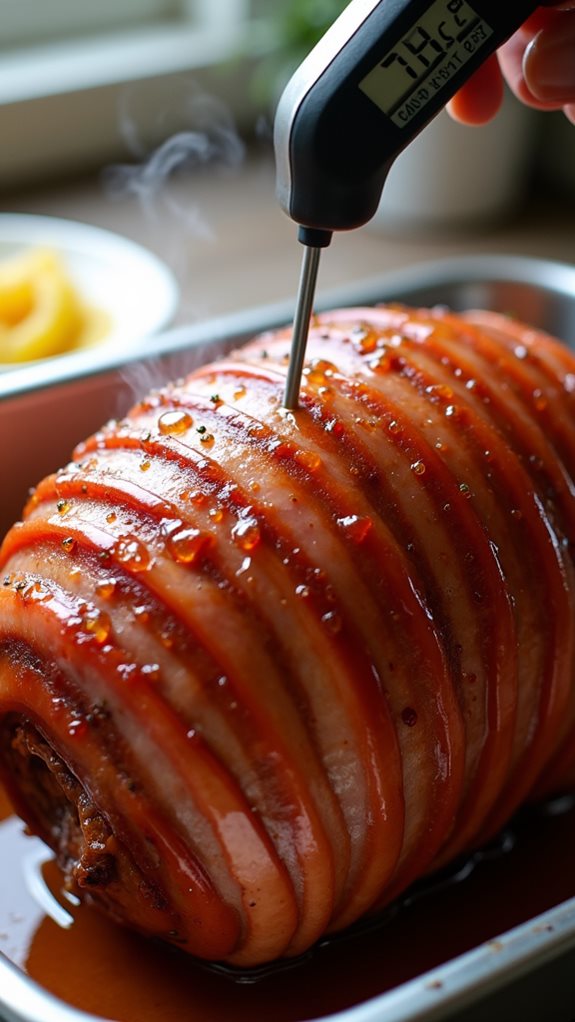
Properly checking your ham's internal temperature stands as the most crucial step in achieving a perfectly cooked, food-safe result.
You'll want to insert a meat thermometer into the thickest part of the ham, avoiding contact with the bone or any fat pockets, as these can give inaccurate readings. Your target temperature should be 140°F (60°C), which ensures the ham is thoroughly heated without becoming dry or overcooked.
If you're using a digital thermometer, don't rely on just one reading – check several spots to confirm even heating throughout the meat.
While spiral hams are pre-cooked, proper reheating is essential for both safety and optimal flavor. Once you've reached the target temperature, let your ham rest for 20 minutes before serving to allow the juices to redistribute.
Step 2. Glaze the Honey Coating
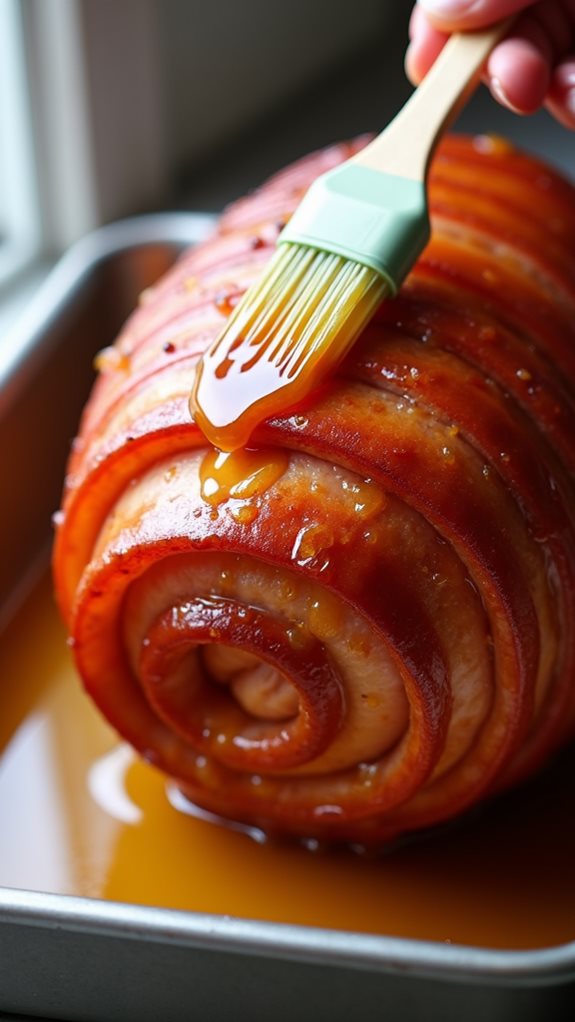
The art of glazing your spiral ham involves three essential steps that ensure a perfectly balanced coating of honey.
First, you'll want to brush half of your prepared honey mixture generously over the entire surface of the ham, making sure it seeps between the pre-cut spiral slices.
After the initial 1.5 hours of covered baking, you'll apply the remaining honey glaze, taking care to distribute it evenly across the ham's surface.
During the final 30 minutes of uncovered baking, the honey will caramelize, creating a rich, golden-brown exterior.
Don't worry if some of the glaze pools at the bottom of the pan – these drippings will combine with the ham's natural juices to create a delicious basting liquid you can spoon over the meat before serving.
Step 3. Make Pineapple Chutney Mixture
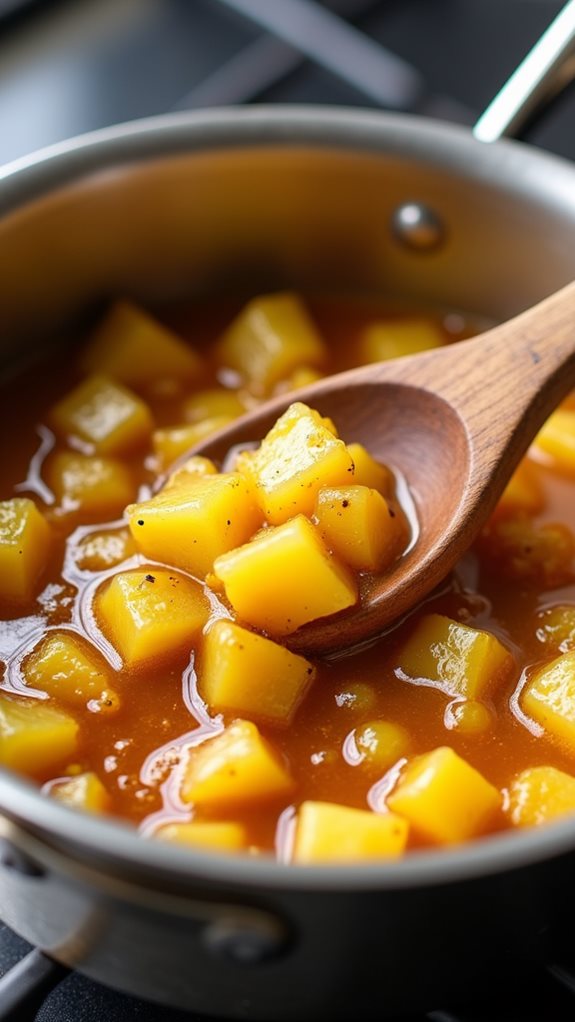
While your ham bakes to perfection, creating the accompanying pineapple chutney will elevate the dish from simple to sublime.
In a medium saucepan, combine your crushed pineapple, brown sugar, and apple cider vinegar, stirring well to ensure the sugar dissolves completely.
Place the mixture over medium heat and bring it to a gentle simmer, making sure you don't let it reach a rolling boil.
You'll want to maintain this simmer for about 15 minutes, stirring occasionally to prevent sticking and encourage even thickening.
You'll know your chutney is ready when it's reduced and has a slightly sticky consistency.
If you're making it ahead, let it cool completely before transferring to an airtight container for refrigeration.
Step 4. Rest Meat Before Slicing
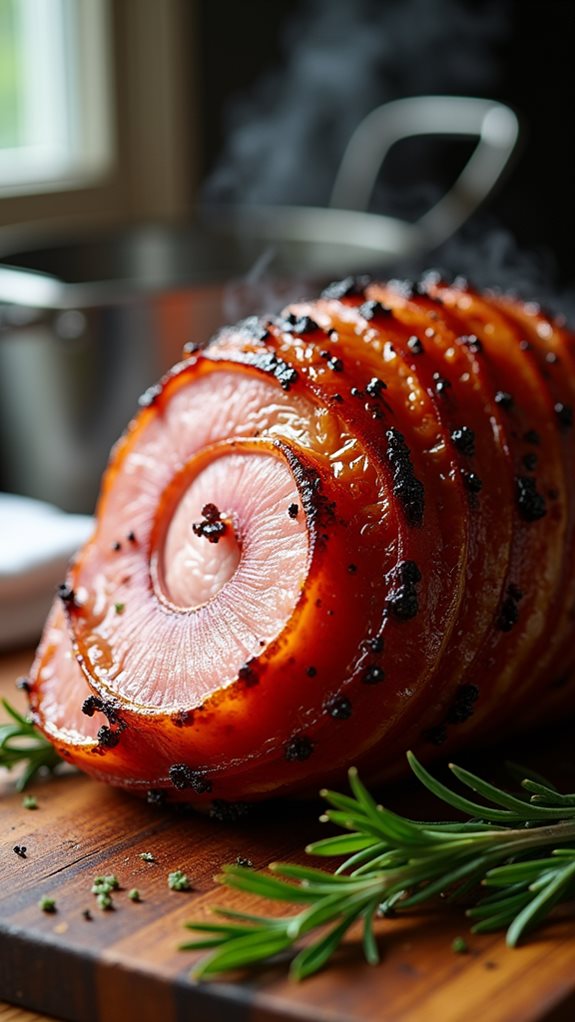
Once your honey-glazed ham reaches an internal temperature of 140°F (60°C), you'll need to resist the temptation to slice into it immediately.
Instead, remove the ham from the oven and let it rest for at least 20 minutes, keeping it loosely covered with foil to retain warmth. During this crucial resting period, the meat's internal juices will redistribute throughout the ham, ensuring each slice remains moist and flavorful when served.
While you're waiting, you can take this time to warm up your prepared pineapple chutney and arrange your serving platter.
If you notice any juices collecting in the roasting pan, don't discard them – you can drizzle these flavorful drippings over the sliced meat for extra moisture and taste.
Step 5. Serve With Decorative Garnish
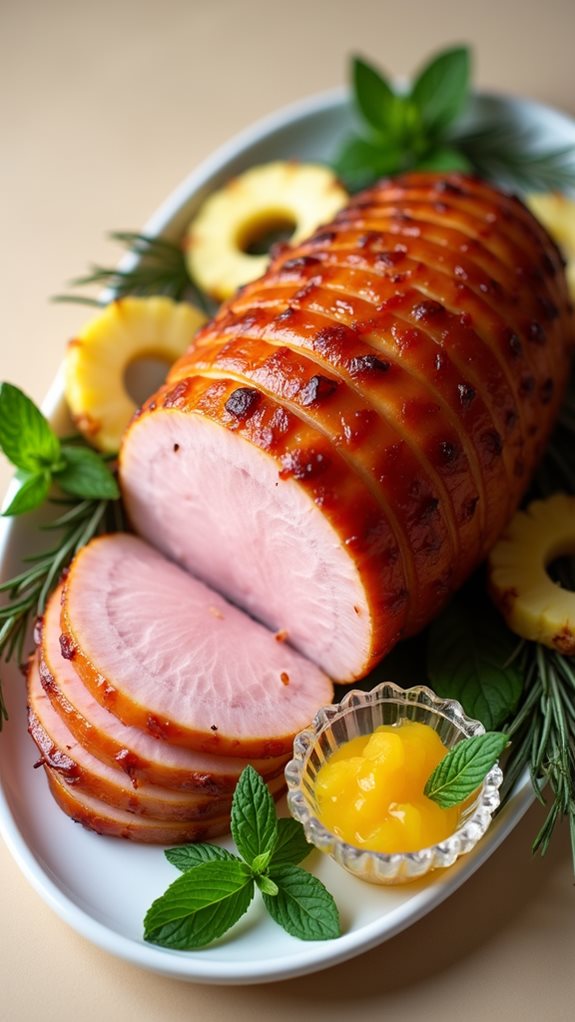
Dress up your honey-glazed spiral ham with elegant garnishes that'll transform this centerpiece from delicious to spectacular.
Arrange fresh pineapple rings around the base of your platter, and tuck sprigs of fresh herbs like rosemary or thyme between the slices for a pop of color. You'll want to place small bowls of the warm pineapple chutney strategically around the platter, making it easily accessible to your guests.
For an extra touch of sophistication, create a bed of fresh mixed greens beneath the ham, and scatter caramelized pineapple chunks around the platter.
Don't forget to add a few whole star anise or cinnamon sticks near the ham's base for visual interest and a subtle hint of the warm spices that complement the honey glaze.
Final Thoughts
Although making a honey-glazed spiral ham requires some time and attention, you'll find the results are well worth the effort. The combination of sweet honey glaze and tangy pineapple chutney creates a memorable centerpiece that's perfect for special occasions or holiday gatherings.
You'll discover that the leftovers are just as delicious, making this dish a practical choice for feeding a crowd.
Remember to monitor the ham's temperature carefully during cooking, and don't skip the resting period, as it allows the juices to redistribute throughout the meat.
If you're planning ahead, you can prepare the pineapple chutney in advance, which will give you more time to focus on other dishes when hosting your meal.















